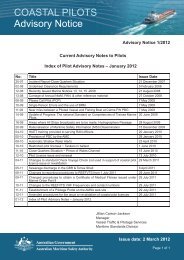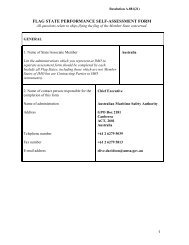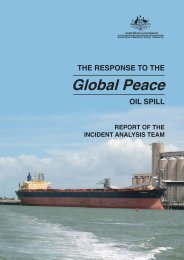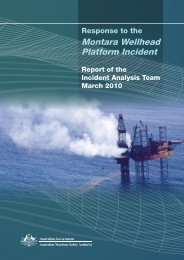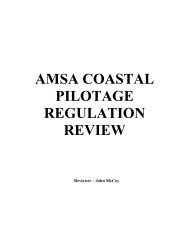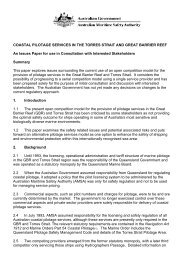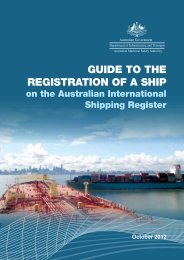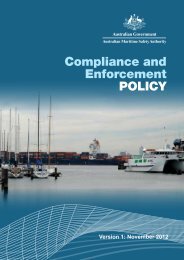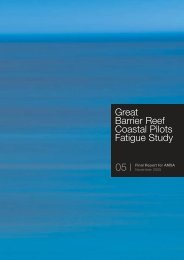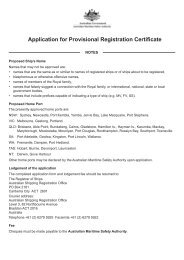Marine Order 32 (Cargo handling equipment) - Australian Maritime ...
Marine Order 32 (Cargo handling equipment) - Australian Maritime ...
Marine Order 32 (Cargo handling equipment) - Australian Maritime ...
Create successful ePaper yourself
Turn your PDF publications into a flip-book with our unique Google optimized e-Paper software.
Dock work safety Schedule 110 4 ohms and not more than 25 x 10 4 ohms when measured between thewheel hub and a conductive plate on which the wheel rests; and(f) single metal wheels, the configuration being 4 on a rectangular base; or(g) power-assisted steering pivoting the rear wheels which are to be remotefrom the load; and(h) pedal hydraulic brakes and a separate parking brake, all complying withclause 13 of <strong>Australian</strong> Standard AS 1915; and(i) all electrical <strong>equipment</strong> including controls and lights, protected incompliance with International Protection 64 (IP64) of <strong>Australian</strong> StandardAS 1939; andNote For the operational environment of the vehicle, see Standard AS/NZ 4745-2004,definition of class II hazardous area.(j) a normal operating temperature not exceeding 135°C (temp T4) in anambient temperature of 40°C when tested in accordance with clause 15 of<strong>Australian</strong> Standard AS 1915; andNoteIgnition temperatures for flammable liquids, gases and volatile solids are given in NFPApublication <strong>32</strong>5M which is available for inspection at Standards Australia libraries at Sydneyand Melbourne.(k) the following durable and conspicuous markings:(i) identification of manufacturer or <strong>Australian</strong> agent;(ii) temperature class as determined in accordance with <strong>Australian</strong> StandardAS 1915;(iii) hazardous area classification as determined in accordance with<strong>Australian</strong> Standard AS 2430.1;(iv) gross mass of the vehicle;(v) safe working load;and complying with the following provisions of <strong>Australian</strong> Standard AS 1915:(l) clause 8 — battery and battery container;(m) clause 9 — plug and socket connectors;(n) clause 10 — electrical protection;(o) clause 11 — cabling.4.2.1.4 In relation to class 1 dangerous goods specified by the IMDG Code to bedivision 1.1 or division 1.2 goods of compatibility group D, or division 1.3, 1.4or 1.5 goods other than those of compatibility groups J or L, a fork lift vehiclepowered by batteries carried on the vehicle may be used in loading or unloadingprovided the vehicle complies with <strong>Australian</strong> Standard AS 2359.1 for a class IIhazardous area.4.2.1.5 A powered mechanical stowing appliance carrying class 1 dangerous goods in avessel must be operated only on electrically conductive surfaces to ensurecontinuous earthing of the appliance.4.2.1.6 Subclauses 4.2.1.3, 4.2.1.4 and 4.2.1.5 do not apply in relation to the loading orunloading of class 1 dangerous goods packed in a cargo transport unit.4.2.1.7 Freight containers packed with Dangerous Goods of Class 1, other than those indivision 1.4 Compatibility Group S, must not be lifted by means of tyne pockets.<strong>Marine</strong> <strong>Order</strong> <strong>32</strong> (<strong>Cargo</strong> <strong>handling</strong> <strong>equipment</strong>) 2011 25MO<strong>32</strong> modcomp-130604Z.docx




